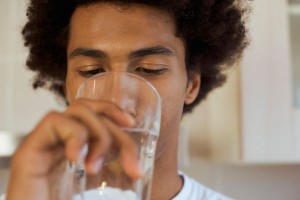EARTHTALK: Perchlorate in drinking water
EARTHTALK: Perchlorate in drinking water
Dear EarthTalk: What is “perchlorate” in our drinking water supply and why is it controversial?– David Sparrow, Chico, CA

Eleven million Americans live in areas where concentrations of perchlorate -- a chemical used in the production of rocket fuel, missiles, fireworks, flares and explosives -- are significantly higher in public drinking water supplies than what is considered safe. PHOTO: Comstock/Thinkstock
Perchlorate is both a naturally occurring and man-made chemical used in the production of rocket fuel, missiles, fireworks, flares and explosives. It is also sometimes present in bleach and in some fertilizers. Its widespread release into the environment is primarily associated with defense contracting, military operations and aerospace programs.
Perchlorate can be widespread in ground water, soils and plants, and makes its way up the food chain accordingly—even into organically grown foods. To wit, A 2005 Journal of Environmental Science and Technology study using ion chromatography to find contaminants in agricultural products found quantifiable levels of perchlorate in 16 percent of conventionally produced lettuces and other leafy greens and in 32 percent of otherwise similar but organically produced samples. Today, traces of perchlorate are found in the bloodstreams of just about every human on the planet.
Perchlorate in the environment is a health concern because it can disrupt the thyroid’s ability to produce hormones needed for normal growth and development. Besides its potential to cause endocrine system and reproductive problems, perchlorate is considered a “likely human carcinogen” by the U.S. Environmental Protection Agency (EPA). Some 11 million Americans live in areas where concentrations of perchlorate in public drinking water supplies are significantly higher than what is considered safe.
Per the mandate of the Safe Drinking Water Act, the EPA is currently working on setting national standards for how much perchlorate can be allowed in drinking water without putting people at risk. As part of the process, the agency is studying the available science on the health effects of perchlorate exposure and evaluating laboratory methods for measuring, treating and removing perchlorate in drinking water. The EPA will publish a proposed rule on the matter for public review at some point in 2013.
“We are happy that the EPA is moving ahead with a drinking water standard…but we are concerned that it won’t be strict enough,” reports Renee Sharp of the nonprofit Environmental Working Group (EWG). The group would like to see the U.S. adopt “a truly health-protective drinking water standard lower than 1 ppb [parts per billion]” for perchlorate. Insiders don’t believe federal policymakers will go that low, however, since the EPA says it cannot detect perchlorate below 2 ppb. But EWG point out that Massachusetts is already testing for it with a 1 ppb cut-off, per the mandate of its statewide standard set back in 2006.
The only other state to have a drinking water standard for perchlorate is California, which set 6 ppb or less as an allowable concentration back in 2004. But that state’s Office of Environmental Health Hazard Assessment recently proposed lowering the standard to 1 ppb based on new data regarding environmental exposure, possible effects of perchlorate and consideration of infants as a susceptible population.
If the EPA develops a tough new standard, almost every state will need to readjust its water monitoring systems to take into account how much perchlorate is making its way to our taps and into the foods we eat—a no doubt costly process but one that will greatly benefit both current and future generations.
CONTACTS: Environmental Working Group, www.ewg.org; EPA Perchlorate Info, http://water.epa.gov/drink/contaminants/unregulated/perchlorate.cfm.
EarthTalk® is written and edited by Roddy Scheer and Doug Moss and is a registered trademark of E – The Environmental Magazine (www.emagazine.com). Send questions to: earthtalk@emagazine.com. Subscribe: www.emagazine.com/subscribe. Free Trial Issue: www.emagazine.com/trial.



Comments (0)